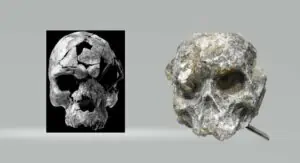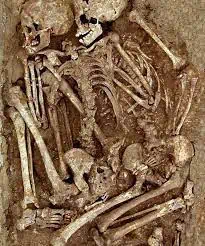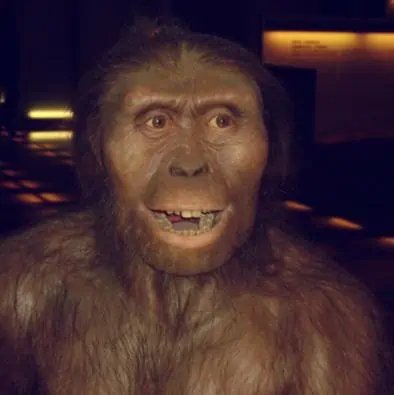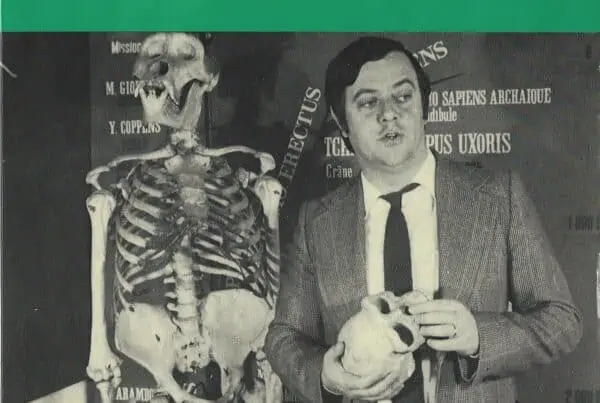Homo sardiniensis, “Tatana is about 150 to 250 thousand years old.”
A Hominid skull was discovered 2 years ago in Italy. It was recently dated to 180kya. It is an archaic Homo sapien. This find will upset the timeline for modern Homo sapiens and rearrange Hominid phylogenetic maps when it is released.
The fact that it was discovered in Italy on the European continent will be hugely disruptive to the paleo-anthropology establishment who endorse recent Out of Africa.
The location of the discovery is Sardinia. They are calling it Sardinia 1. Nicknames are often given to Hominid skulls like the famous Lucy. Sardinia 1 will be named Tatana.
Note – They are unsure at this point, if it is male or female, but lean heavily towards female.
 The skull has an interesting backstory. It was unearthed years ago by a local farmer on his property in southwestern Sardinia, near the coast. The farmer kept it as a conversation piece. Recently the new owners turned it over to local historians/antiquities experts. They concluded it was not contemporary and soon after sought expert advice, including consulting paleontology experts on the Italian mainland.
The skull has an interesting backstory. It was unearthed years ago by a local farmer on his property in southwestern Sardinia, near the coast. The farmer kept it as a conversation piece. Recently the new owners turned it over to local historians/antiquities experts. They concluded it was not contemporary and soon after sought expert advice, including consulting paleontology experts on the Italian mainland.
Alan VanArsdale is a professional precious jewels miner, numismatist and wilderness trekker/archaeologist from Utah. He spends part of his year living and working in Colorado and Idaho. He is a graduate of the University of California-Berkeley studying sedimentary geology and vertebrate paleontology. His studies included research on anthropologist C. Loring Brace (photo). He worked for a brief period in the lab of famed paleo-anthropologist Dr. Tim White.
VanArsdale hosts a popular Facebook group on paleo-anthropology. He was a guest recently on an episode on the Cave Dwellers, The Neanderthal Mind.
VanArsdale was brought in to consult on the project, specifically on stratigraphy and soil samples.
VanArsdale:
 To think of Sardinia 1 (right) as African is incorrect. Herto (left) was African, but with a lot of gene flow coming first from the West within Africa then a second big push of net gene flow coming down from the North.
To think of Sardinia 1 (right) as African is incorrect. Herto (left) was African, but with a lot of gene flow coming first from the West within Africa then a second big push of net gene flow coming down from the North.
Sardinia 1 shares the net gene flow from the West of Africa with herto, and has even more gene flow from the great Southern Eurasian archaic gene pool than Herto has. So they have a lot in common, but are on other sides of the Arabo-Saharan and Mediterranean partial barriers to gene flow. No “replacements” ever. Just enough gene flow to give a lot of commonality.
Related to the famous Grimaldi Man discovered in the early 20th century?
Asked further about the discovery VanArsdale mentioned similarities with the Grimaldi skeletons found in northwest Italy in the 1920s, from the Gravettian period dated to 26,000 years ago.
 Grimaldi skeletons discovered in Baoussé Rossé one the Cote de Azure. It is debated whether he is neanderthal, cro-magnon, or something else entirely.
Grimaldi skeletons discovered in Baoussé Rossé one the Cote de Azure. It is debated whether he is neanderthal, cro-magnon, or something else entirely.
He even suggested a direct relationship.
“Grimaldi is from right by the border of France and was near the sea then (as the topography there is rather steep). Yes NW Italy. Grimaldi until the 1960’s, and still in Eastern Europe, was thought to be African due to the high alveolar and mandibular prognathy.”
As a result of Grimaldi together with Homo sardiniensis, he predicts, “Italy [will prove] more central than East Africa to the origin of modern humans.”
Further assessment from VanArsdale:
Tatana has the nearly vertical forehead (with considerable distortion and flattening of the face in the fossil). With a relatively small mid face. So despite the very primitive dentition, more primitive than any other modern human, Tatana is certainly a modern human… the oldest firm modern human from Europe. Tatana is about 150 to 250 thousand years old. As much as 180 thousand years old as little as 120 thousand years old only if some sort of relic as a result of insularism in the general Italian region.
Our Interview with Stefano Giovanni Loi of Sardinia, Co-Discoverer of Homo sardiniensis
 We recently had the opportunity to interview one of of the co-discoverers of Homo sardieniensis – Stefano Giovanni Loi. (His blog on paleo-anthropology). He is an antiquities expert and local historian in Sardinia. He speaks only limited English.
We recently had the opportunity to interview one of of the co-discoverers of Homo sardieniensis – Stefano Giovanni Loi. (His blog on paleo-anthropology). He is an antiquities expert and local historian in Sardinia. He speaks only limited English.
Subspecieist: Was it really found in a wall with plaster? Old farmer used it as an art piece? Do we have the story correct?
(Translation – The first human beings arrived in Sardinia during the glaciations walking through Tuscany and traversing Corsica.)
Editor’s Note – I am fluent in Italian. I have traveled to Italy twice – Roma, Pisa, Lucca.
The translation is mine, not from automated translation tools. My inter-lingual translation style is mostly literal, word for word. This is sometimes referred too as meta-phrase versus the paraphrase (interpretive) style. Literal translation style, while intelligible, is not necessarily grammatically correct English. However, in my view it allows for non-Italian speakers to more easily recognize cognates within each sentence. An example: “I primi esseri umani sono arrivati…” to “The first human beings had arrived…”





Very nice writing style. Great topic.
This is a hoax